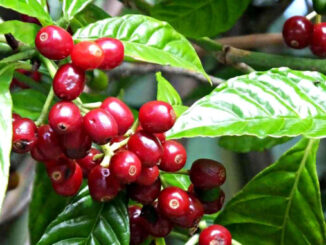
The CxR coffee variety — short for Caturra × Robusta — is a remarkable Arabica–Robusta hybrid developed to unite the best characteristics of both species.
It offers Arabica’s smooth taste and aroma while inheriting Robusta’s hardiness, disease resistance, and productivity.
This hybrid has become especially important in regions where Arabica struggles due to climate stress, pests, or low-altitude growing conditions.
🌿 Botanical Classification
- Scientific name: Coffea arabica × Coffea canephora
- Common name: CxR (Caturra × Robusta)
- Parent varieties:
- Caturra — a compact, high-yield Arabica variety (from the Bourbon line)
- Coffea canephora — commonly known as Robusta
- Developed in: India (Central Coffee Research Institute – CCRI)
The CxR hybrid is the result of cross-pollination between Arabica and Robusta, designed to blend cup quality and resilience in one variety.
🌍 Origin and Development
The CxR hybrid was developed in India by the Central Coffee Research Institute (CCRI) to help farmers combat coffee leaf rust, nematodes, and climate instability.
Caturra provided the cup quality and manageable size, while Robusta contributed resistance to pests, vigor, and tolerance to heat and poor soils.
This made CxR ideal for cultivation in southern India’s low and mid-elevation plantations.
Since then, the variety has spread to Sri Lanka, Indonesia, Vietnam, and parts of Africa, where it performs well in tropical conditions.
🌱 Plant Characteristics
The CxR plant exhibits a mix of traits from both parent species:
- Height: Medium — smaller than Robusta, larger than typical Caturra
- Growth habit: Semi-upright, compact, and manageable for pruning
- Leaves: Broad, dark green, and leathery
- Beans: Medium-sized, rounder than Arabica but larger than Robusta
- Root system: Deep and strong — excellent drought tolerance
- Yield: High and consistent, even in variable climates
CxR’s robust structure and adaptability make it suitable for both shade-grown and open-field systems.
☕ Flavor Profile
CxR coffee offers a balanced cup that bridges the gap between Arabica’s finesse and Robusta’s strength.
Typical tasting notes:
- Medium body with smooth texture
- Mild acidity
- Nutty and chocolaty undertones
- Subtle spice and earthy notes
- Balanced bitterness with sweet aftertaste
While not as delicate as pure Arabica, CxR’s flavor is far superior to most Robusta types — making it ideal for espresso blends and commercial-grade single origins.
💧 Growing Conditions
CxR was bred to perform in challenging tropical environments where Arabica struggles.
Optimal conditions:
- Altitude: 400–1,000 meters
- Temperature: 20–30°C
- Rainfall: 1,200–2,000 mm annually
- Soil: Well-drained, slightly acidic (pH 5.5–6.5)
- Shade: Performs well under moderate shade or mixed cropping
CxR thrives in India, Sri Lanka, Vietnam, and lowland East Africa, where traditional Arabica is vulnerable to pests or high heat.
🌾 Agricultural Advantages
✅ High yield — better productivity than most Arabicas
✅ Resistance to coffee leaf rust and nematodes
✅ Tolerance to high temperatures and humidity
✅ Good adaptability to low altitudes
✅ Moderate cup quality — suitable for both blends and standalone use
✅ Lower maintenance cost
Because of these strengths, CxR is often grown in commercial estates and mixed-crop farms alongside pepper, cocoa, or coconut.
⚠️ Challenges and Limitations
❌ Less aromatic than pure Arabica
❌ Flavor consistency can vary by altitude and processing
❌ Requires good pruning for optimum yield
❌ Beans are harder to roast evenly due to density variation
Despite these minor drawbacks, CxR is valued for its economic stability and reliability under climate stress.
🧬 Genetic Significance
CxR is part of a larger group of Arabica–Robusta hybrids developed to combine quality and resilience — others include Catimor, Sarchimor, and Arabusta.
Its genetics are particularly interesting because:
- It carries Arabica flavor genes (from Caturra)
- It includes Robusta resistance genes, offering leaf rust immunity
- It provides a base for breeding programs aiming to create lowland, high-quality coffees
In India, CxR has also been cloned and improved to create uniform, high-yielding plants for replanting programs.
☕ Uses in Coffee Blends
CxR’s cup characteristics make it a favorite base coffee for:
- Espresso blends (adds crema and body)
- Instant coffee (provides flavor depth and caffeine strength)
- Commercial roasts in tropical countries
When roasted medium to dark, CxR produces a smooth, balanced flavor with strong crema — perfect for milk-based drinks like cappuccinos and lattes.
🌍 Impact on Sustainable Coffee Farming
As climate change threatens traditional Arabica crops, hybrids like CxR are becoming vital.
Their adaptability, high yield, and resilience make them excellent candidates for sustainable, low-input farming systems.
Farmers benefit from:
- Reduced pesticide use
- More consistent harvests
- Better tolerance to erratic weather patterns
CxR is thus a symbol of the future of coffee breeding — balancing cup quality with agricultural endurance.
❤️ Final Thoughts
The CxR (Caturra × Robusta) coffee variety bridges the gap between quality and strength.
It offers the flavor appeal of Arabica with the reliability and resistance of Robusta, making it a cornerstone for sustainable coffee cultivation in tropical regions.
While it may never replace pure Arabica in specialty markets, its role in ensuring a stable and resilient coffee future is undeniable.
☕ CxR — where Arabica elegance meets Robusta power.
DeliciousPath: Enjoyment in Every Moment
Explore the Gourmet on Board category for exquisite flavors that elevate your meals, even when you’re on a boat, and the Coffee category for aromatic coffee blends that make every moment special. DeliciousPath is here to turn every experience into something unforgettable!
























